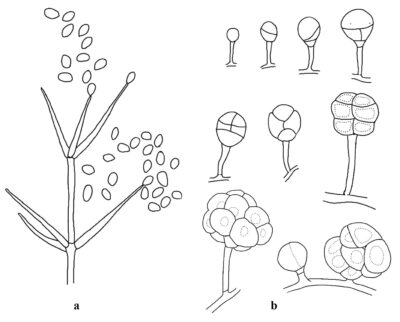Fungalpedia – Note 411, Metapochonia
Metapochonia Kepler, S.A. Rehner & Humber
Citation when using this data: Tibpromma et al. 2024 (in prep.) – Fungalpedia, Ascomycota.
Index Fungorum, Facesoffungi, MycoBank, GenBank, Fig. 1
Classification: Clavicipitaceae, Hypocreales, Hypocreomycetidae, Sordariomycetes, Pezizomycotina, Ascomycota, Fungi.
Based on morphology and multigene phylogenetic analysis of TUB, RPB1, RPB2 and TEF1-α, Metapochonia was introduced by Kepler et al. (2014) as a monotypic genus within Clavicipitaceae to accommodate the type species Metapochonia suchlasporia and another four species (M. bulbillosa, M. goniodes, M. microbactrospora and M. rubescens). Zhang et al. (2017) described a new cave-inhabiting species (M. variabilis) from karst caves in Guizhou Province, China. One new species (M. lutea) and two new combinations were described by Labuda et al. (2018). Nine species have been accepted in Metapochonia, with only the known sexual morph distributed widely worldwide (Kepler et al. 2014). This genus is mainly characterized by whorled or singular slender, awl-shaped phialides and stalked, thick-walled, multicellular dictyochlamydospores (Kepler et al. 2014). Most species of Metapochonia have been reported as pathogens of nematodes and rotifers and are isolated from soil or substrates of plant roots (Kepler et al. 2014).
Type species: Metapochonia suchlasporia (W. Gams & Dackman) Kepler, Rehner & Humber
Other accepted species: Species Fungorum – search Metapochonia
Figure 1 – Morphological features of Metapochonia suchlasporia. a Conidiophores and conidia. b Development of dictyochlamydospores. Redrawn from Zare et al. (2001).
References
Entry by
Liu XF, Center for Yunnan Plateau Biological Resources Protection and Utilization, College of Biological Resource and Food Engineering, Qujing Normal University, Qujing, Yunnan 655011, China; Center of Excellence in Fungal Research, Mae Fah Luang University, Chiang Rai 57100, Thailand; School of Science, Mae Fah Luang University, Chiang Rai 57100, Thailand.
(Edited by Saowaluck Tibpromma, Samaneh Chaharmiri-Dokhaharani, & Achala R. Rathnayaka)
Published online 26 November 2024
